The weeks following publication of a book are crammed with conversations about the book – what it says, how you wrote it, why you wrote it, what people think. And those conversations about “The Crusades of Cesar Chavez” have been intense and wonderful. But among the most enjoyable parts of the just-having-published-a-book-time for me are seeing new cities (discovering ceramic fish swimming under a San Antonio bridge) and meeting unexpected people. Like Luis Valdez’s high school English teacher, a mentor who profoundly influenced the teenager from a farmworker family who grew up to be the father of Chicano theater.
The white-haired gentleman in the front row (looking far younger than his 85 years) nodded attentively during my talk to undergrad and graduate students at UT Austin earlier this month. Then he came up and introduced himself as Ed Farrell. Farrell recalled how he had first heard about Luis Valdez from his older brother, Frank, when Frank was a senior at James Lick High School in San Jose in 1956. You’ll be lucky to get my brother because he’s a really good writer, Frank, no slouch himself, told his teacher. The next year, Farrell taught Luis in junior English, and the two formed a bond that has endured more than five decades. When the two eldest children were in high school, the Valdez family of 10 lived in a small Quonset hut, Farrell recalled. An abandoned car in the driveway became the boys’ study – a quiet place with light. Both had deep, resonant voices and starred on the debate team. But when Luis clearly won a major state contest, the ballots were mysteriously lost and the winner never announced. Luis has told me that Farrell became an important influence and mentor, encouraging him to write even as he entered San Jose State as an engineering major. What a treat to meet Ed Farrell and his wife, JoAnn, just before the avid travelers set off for Moscow!
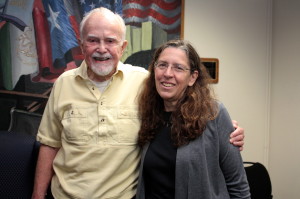
From Austin I headed to the San Antonio Book Festival, only in its second year but a terrific, well-run event with enthusiastic audiences.
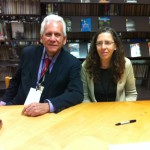 Playwright and critic Gregg Barrios asked thoughtful, probing questions and was a thoroughly enjoyable conversation companion, on and off stage. Our talk will be aired on C-SPAN BOOKTV this Saturday at 1:45 EST/10:45 PST, and should be available on line after that.
Playwright and critic Gregg Barrios asked thoughtful, probing questions and was a thoroughly enjoyable conversation companion, on and off stage. Our talk will be aired on C-SPAN BOOKTV this Saturday at 1:45 EST/10:45 PST, and should be available on line after that.
At Arizona State University in Phoenix, Matt Garcia, a fellow UFW scholar and head of the School of Historical, Philosophical and Religious Studies, organized a two day symposium that included discussions of my book as well as the Diego Luna movie and also honored some of the farm worker movement veterans at the historic Santa Rita Center (where Chavez held his second major fast, in 1972).
In the picture below, Matt and I listen to Gilbert Padilla, one of the movement’s founders, talk about his experiences. Next to Gilbert is Gretchen Laue; her husband, Mario Bustamante, is just out of sight.
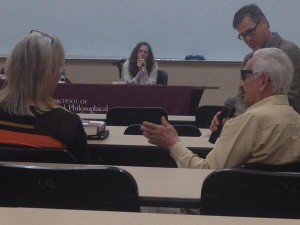 Gretchen was a UFW volunteer when she met Mario, a lettuce cutter, in 1979. They are two of the eight principal characters in my first book, “The Union of Their Dreams” and having them at the book talk I gave at Changing Hands bookstore (a great indie) added a lot to the event. I always find that audiences like meeting people who are in my books even more than they like meeting the author.
Gretchen was a UFW volunteer when she met Mario, a lettuce cutter, in 1979. They are two of the eight principal characters in my first book, “The Union of Their Dreams” and having them at the book talk I gave at Changing Hands bookstore (a great indie) added a lot to the event. I always find that audiences like meeting people who are in my books even more than they like meeting the author.
Finally, the week ended at the always fantastic Los Angeles Time Festival of Books, where I had the great privilege of sharing the stage (a very large stage, too, in USC’s Bovard auditorium!) with two superstars, LAT columnist and author Steve Lopez, and Eliseo Medina, veteran of the farmworker movement, until recently the secretary-treasurer of the SEIU, and now leading the fight for immigration reform. We talked to several hundred people and then sold a ton of books, which I credit mainly to those two. Eliseo delivered a moving description of what life was like for a farmworker in Delano in the early 1960s, and the difference Cesar Chavez made. 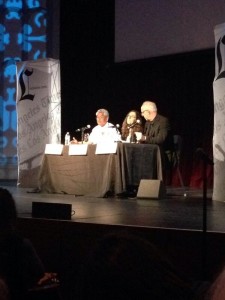
After the program, Eliseo had a reunion with Chris Hartmire, who headed the Migrant Ministry and was one of the UFW’s earliest and key supporters, and the two of them (also main characters in “Union of Their Dreams”) signed books, too. 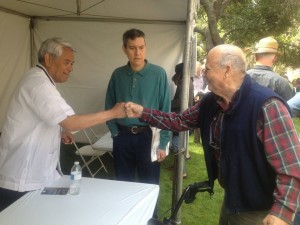
At the Festival of Books, I also had a chance to meet Diego Luna, whose “Cesar Chavez” movie came out at the same time as my book, so we’ve been written about together quite a bit in recent weeks. He has put a lot of time into appearing on college campuses and different venues to help promote the film, and at the FOB he read a children’s book out loud, “Cesar Chavez y la Maquina del Tiempo,” and then signed copies. So I gave him a copy of the biography and picked up the graphic story book
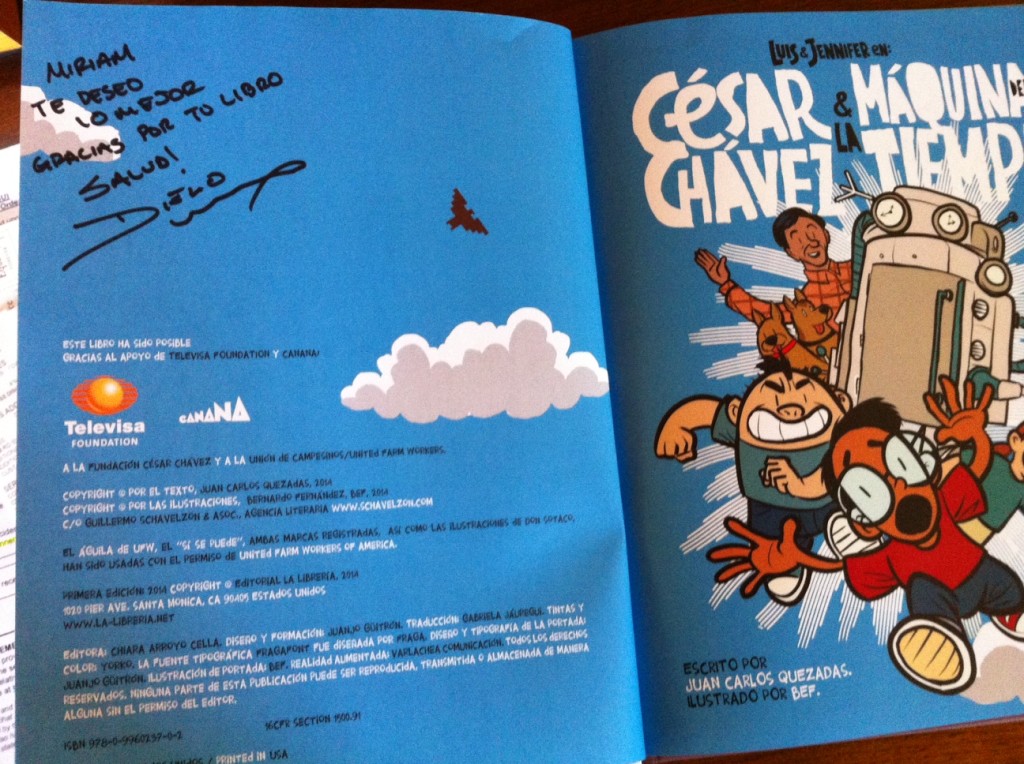
Back to ASU for a minute. Scott Washburn, another UFW veteran who has worked for more than two decades for SEIU, joined us for all the events in Phoenix and lent his perspective and wisdom to conversations about Chavez and the rich history of the farmworker movement in Arizona. Scott also forms a tie between the past and present. He recently helped run the 22-day fast that Eliseo and two other immigrants led on the National Mall to draw attention to the cause of reforming the nation’s broken immigration laws. The tactics of Chavez and the old UFW are very much alive in the immigration rights movement today. Each night during the fast, Scott led a community meeting and held up the shoe of a migrant who had died trying to cross the Arizona desert. Here’s one of my favorite pictures: Washburn showing the shoe to the president when Obama visited the fasters in tent.

And finally, about those ceramic fish … They’re part of the public art on display along the museum section of Riverwalk, a lovely path that meanders for miles through San Antonio.
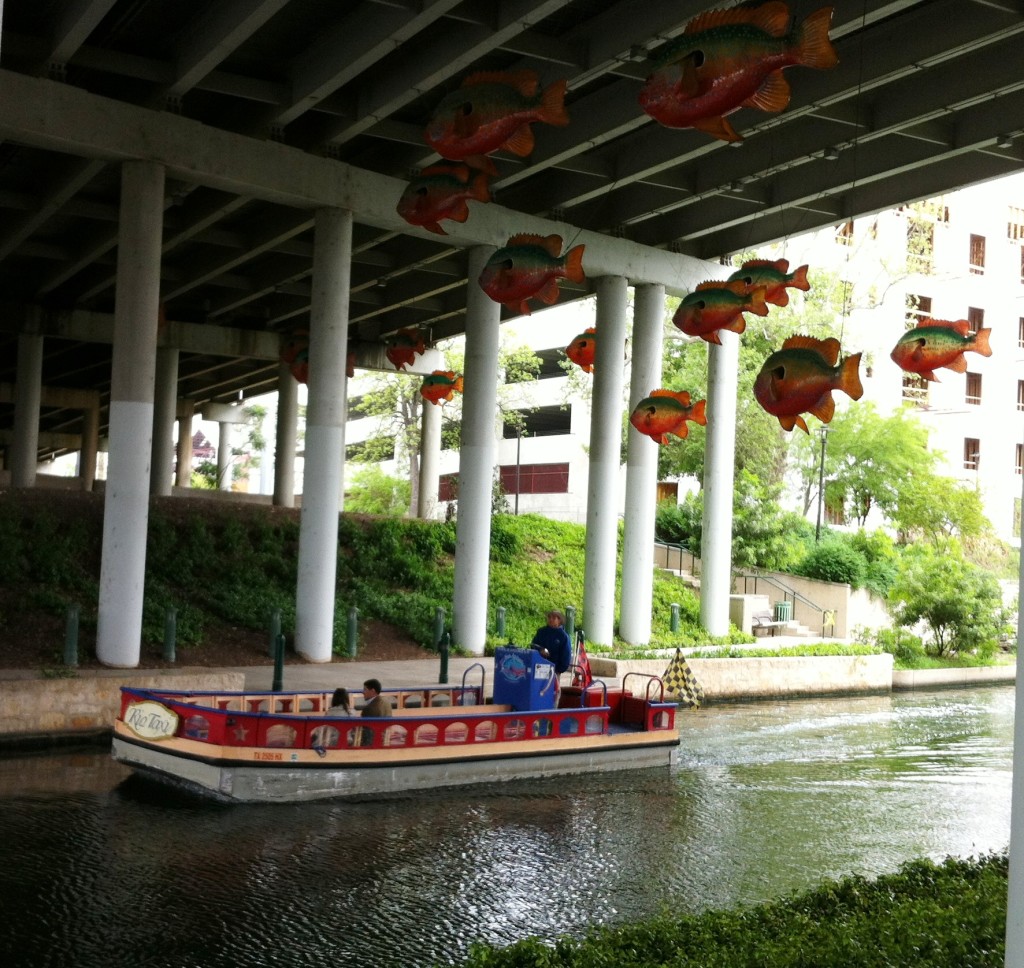
No comments yet.